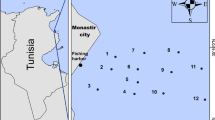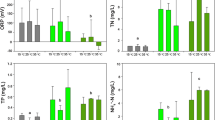Abstract
The survival rate, metabolic activity, and ability for growth of microbial communities of Lake Baikal have been first studied after exposure to extremely low temperatures (freeze-thawing) for different lengths of time. It has been shown that short-term freezing (1–3 days) inhibits the growth and activity of microbial communities. The quantity of microorganisms increased after 7-and 15-day freezing. In the periods of maximums, the total number of microorganisms in the test samples was twice as high as in the control. It was established that after more prolonged freezing the microorganisms required more time after thawing to adapt to new conditions. In the variants with 7-and 15-day freezing, the activities of defrosted microbial communities were three or more times higher than in the control. The survival rate and activity of Baikal microorganisms after freeze-thawing confirms the fact that the Baikal microbial communities are highly resistant to this type of stress impact.
Similar content being viewed by others
References
Lyakh, S.P., Adaptatsiya mikroorganizmov k nizkim temperaturam (Adaptation of Microorganisms to Low Temperatures), Moscow: Nauka, 1976.
Feofilova, E.P., Deceleration of Vital Activity as a Universal Biochemical Mechanism Ensuring Adaptation of Microorganisms to Stress Factors: A Review, Prikl. Biokhim. Mikrobiol., 2003, vol. 39, no. 1, pp. 5–24 [Appl. Biochem. Microbiol. (Engl. Transl.), vol. 39, no. 1, pp. 1–18].
Slabova, O.I., Oranskaya, M.S., and Nikitin, D.I., Development of Oligotrophs at Low Temperature, Mikrobiologiya, 1993, vol. 62, no. 6, pp. 1072–1078.
Suwa, Y. and Hattory, T., Cellular Fatty Acid and Quinine Systems of Oligotrophic Soil Bacteria, J. Gen. Appl. Microbiol., 1986, vol. 32, pp. 451–471.
Romanenko, V.I.and Kuznetsov S.I., Ecology of Freshwater Microorganisms (TRANSLATION), Leningrad: Nauka, 1974.
The Shorter Bergey’s Manual of Determinative Bacteriology, Holt, J.G., Ed., Baltimore: Williams & Wilkins, 1977. Translated under the title Kratkii opredelitel’ bakterii Bergi, Moscow: Mar, 1980.
Lodder, J., The Yeasts. A Taxonomic Study, Amsterdam: North Holland Publ. Co, 1970, p. 713.
Maksimova, E.A. and Maksimov, V.N., Water Microbiology of Lake Baikal, Irkutsk: Irkutsk. Univ., 1989.
Underwood, A.J., The Analysis of Stress in Natural Populations, Biol. J. Linn. Soc., 1989, vol. 37, nos. 1–2, pp. 51–58.
Slabova, O.I., Resistance of Oligotrophs to Stress Factors, Mikrobiologiya, 1988, vol. 57, no. 5, pp. 697–699.
Slabova, O.I. and Nikitin, D.I., Influence of the Incubation Temperature on the Reaction of Oligotrophic Bacteria to Stress, Mikrobiologiya, 2004, vol. 73, no. 6, pp. 758–762 [Microbiology (Engl. Transl.), vol. 73, no. 6, pp. 650–653].
Vorob’eva, L.I., Stressors, Stress Reactions, and Survival of Bacteria: A Review, Prikl. Biokhim. Mikrobiol., 2004, vol. 40, no. 3, pp. 261–269 [Appl. Biochem. Microbiol. (Engl. Transl.), vol. 40, no. 3, pp. 217–224].
Gusev, V.A. and Bobrovskaya, N.I., Mikrobiologicheskie issledovaniya Zapadnoi Sibiri (Microbiological Research in Western Siberia), Novosibirsk: Nauka, 1989.
Martirosova, E.I., Karpekina, T.A., and El’-Registan, G.I., Enzyme Modification by Natural Chemical Chaperons of Microorganisms, Mikrobiologiya, 2004, vol. 73, no. 5, pp. 708–715 [Microbiology (Engl. Transl.), vol. 73, no. 5, pp. 609–615].
Ivanov, S.A. and Puchkov, E.O., Two-stage Freezing of Bacteria to −196°C, Mikrobiologiya, 1988, vol. 57, no. 4, pp. 699–701.
Upton, A.C., Nedwell, D.B., and Wyrr-William, D.D., The Selection of Microbial Communities by Constant of Fluctuating, Temperatures, FEMS Microbiol. Ecol., p. 199.
Helke, E., Weylandg. Bacterial sea ice flora of the Antarctic Ocean during winter // 5th Int. Symp. Microb. Esol. ISME5 Kyoto. Aug. 27–Sept. 1, 1989. Abstr, p. 56.
Author information
Authors and Affiliations
Corresponding author
Additional information
Original Russian Text © V.V. Maksimov, E.V. Shchetinina, O.V. Kraykivskaya, E.A. Maksimova, 2006, published in Mikrobiologiya, 2006, Vol. 75, No. 6, pp. 752–757.
Rights and permissions
About this article
Cite this article
Maksimov, V.V., Shchetinina, E.V., Kraykivskaya, O.V. et al. Response of microbial communities of Lake Baikal to extreme temperatures. Microbiology 75, 653–657 (2006). https://doi.org/10.1134/S0026261706060063
Received:
Issue Date:
DOI: https://doi.org/10.1134/S0026261706060063




